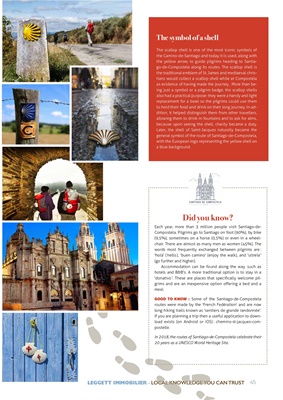
45
LEGGETT IMMOBILIER - LOCAL KNOWLEDGE YOU CAN TRUST
The symbol of a shell
The scallop shell is one of the most iconic symbols of
the Camino-de-Santiago and today it is used, along with
the yellow arrow, to guide pilgrims heading to Santiago-de-Compostela
along its routes. The scallop shell is
the traditional emblem of St. James and mediaeval christians would
collect a scallop shell while at Compostela
as evidence of having made the journey. More than being just a symbol or a pilgrim badge,
the scallop shells
also had a practical purpose: they were a handy and light
replacement for a bowl so the pilgrims could use them
to hold their food and drink on their long journey. In addition, it helped distinguish them from
other travellers,
allowing them to drink in fountains and to ask for alms,
because upon seeing the shell, charity became a duty.
Later, the shell of Saint-Jacques naturally became the
general symbol of the route of Santiago-de-Compostela,
with the European logo representing the yellow shell on
a blue background.
Did you know?
Each year, more than 3 million people visit Santiago-de-
Compostela. Pilgrims go to Santiago on foot (90%), by bike
(9,5%), sometimes on a horse (0,5%) or even in a wheelchair.
There are almost as many men as women (45%). The
words most frequently exchanged between pilgrims are :
'holà' ( hello ), 'buen camino' (enjoy the walk), and 'ultreïa '
(go further and higher ).
Accommodation can be found along the way such as
hotels and B&B's. A more traditional option is to stay in a
'donativo '. These are places that specifically welcome pilgrims and
are an inexpensive option offering a bed and a
meal.
GOOD TO KNOW : Some of the Santiago-de-Compostela
routes were made by the 'French Fedération' and are now
long hiking trails known as 'sentiers de grande randonnée'.
If you are planning a trip then a useful application to download exists
(on Android or iOS) : chemins-st-jacques-compostelle.
In 2018, the routes of Santiago-de-Compostela celebrate their
20 years as a UNESCO World Heritage Site.